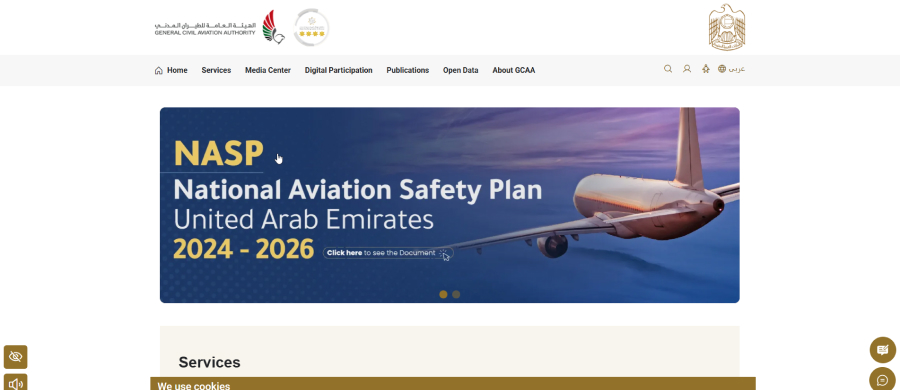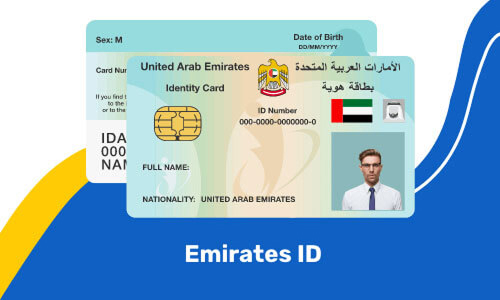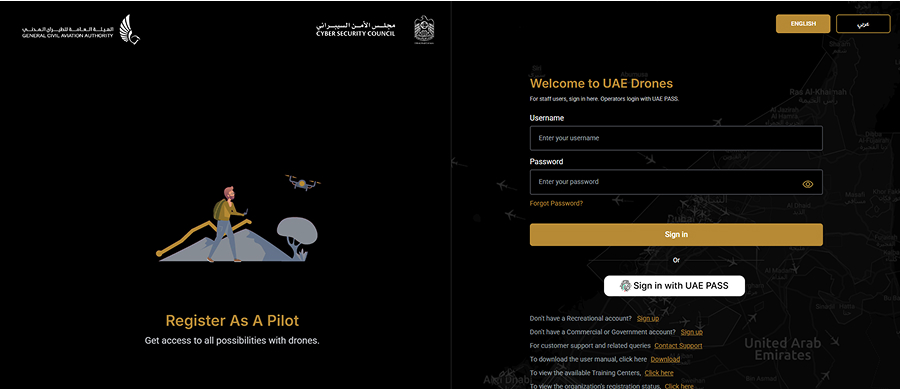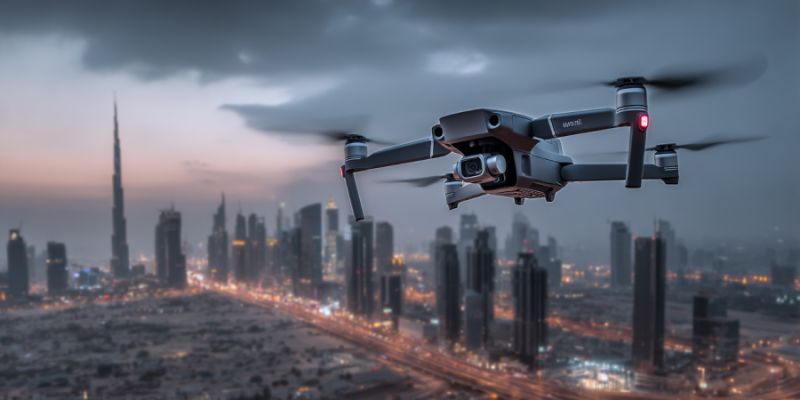Drones are no longer seen as simple gadgets or hobby toys. In the UAE, they have become part of everyday practice across multiple fields. People use them for everyday filming and leisure, while businesses rely on them for far more serious tasks - delivering goods, surveying construction projects, shooting films, or even supporting emergency services. Yet, as the number of drones in the skies increases, a crucial concern arises: how to guarantee safety in a country where passenger planes take off every few minutes and urban areas leave little free space?
The answer to this challenge has been the creation of a clear and strict drone registration system in the UAE. The country, as a regional centre of innovation, realised the need to regulate this area quite early on. Today, registration is a prerequisite for all drone owners - both individuals and organisations. At the same time, the process is not limited to the formal entry of data into the register: it is accompanied by a whole set of rules that affect flight locations, altitude, use of cameras and even the time of day.
For some users, this may seem like a bureaucratic barrier, for others a guarantee of security and privacy protection. But in reality, drone registration in the UAE fulfils several functions at once: it reduces the risk of incidents, ensures control over the airspace and opens up opportunities for the development of new technologies such as drone delivery or future air taxi projects.
In this article, we'll look in detail at exactly how the drone registration system works in the UAE: what steps you need to go through, what documents to prepare, how long the process takes and what mistakes beginners make. We'll also look at the legal framework, restricted areas and practical tips that will help you not only register your device without problems, but also use it responsibly and legally.
Drone registration in the UAE is not just a formality, but a step towards safe and civilised use of technology that will become part of everyday life in the near future.
What are UAS and who controls them in the UAE
Drone regulation in the United Arab Emirates is based on a combination of federal laws and regulations issued by the General Civil Aviation Authority (GCAA). It is this authority that is responsible for controlling unmanned aerial systems (UAS) and ensuring their safe integration into the UAE airspace.
In terms of legislation, a drone is equated to an aircraft, albeit in a simplified form. This means that the basic principles of aviation safety apply to its owner and operator: responsibility for control, the need for registration, and compliance with restrictions on flight zones and technical specifications.
Definitions and classification
GCAA uses the term Unmanned Aircraft System (UAS), which encompasses not only the drone itself, but also everything related to its control: ground station, software, communication channels. Thus, we are talking about a complex system, not just a ‘flying toy’.

General Civil Aviation Authority (GCAA)
UAS users can be divided into three categories:
- Recreational pilots are individuals who use a drone for a hobby or personal filming.
- Commercial operators are companies and professionals who use drones for business purposes (e.g. construction, inspection, logistics or entertainment).
- Government and special organisations are entities that use drones for law enforcement, research, medical delivery or other specific tasks.
The main source of legal drone regulations in the UAE is the federal civil aviation legislation, supplemented by GCAA directives and instructions. Particular attention is paid to articles that deal with:
- operator liability (including possible fines and sanctions in case of infringements);
- ensuring flight safety in the vicinity of airports, military facilities and densely populated areas;
- privacy and personal data protection when using drones with cameras.
- Important: the operator is responsible for violations, even if the drone was provided by a third party.
Powers of the GCAA and local authorities
While the GCAA plays a main role at the federal level, individual emirates (e.g. Dubai or Abu Dhabi) may impose additional requirements and restrictions. This leads to a situation where a drone owner must consider both national and local regulations.
To simplify the procedure, an online registration portal has been created through which all applications are processed. The data is automatically recorded in a centralised system, which makes it possible to control the use of drones and prevent unauthorised flights.
The principle of ‘safety first’
Legal drone regulation in the UAE is based on a strict prioritisation of safety. This is reflected in a number of key regulations:
- drone flights in the UAE are prohibited near airports and in areas with heavy air traffic;
- camera use and video recording require special attention to privacy issues;
- maximum flight altitude and distance from the operator are limited;
- commercial use requires additional authorisation (Unmanned Aircraft Operator Authorisation).
The legal framework in the UAE thus represents a balance between encouraging innovation and strict risk control. On the one hand, drone owners are given the opportunity to officially register their equipment and use it legally. On the other hand, the government reserves strict supervision for drone users in the UAE and the right to impose sanctions to minimise security threats.

Want to learn more about UAE business setup services?
Drone registration in the UAE: for private individuals vs commercial operators
Drone registration in the UAE is mandatory for all users - both individuals and organisations. The main purpose of this procedure is to ensure transparency, reduce risks to aviation and society, and create a system of accountability. However, the requirements differ depending on who the operator is and the purpose for which the drone is being used.
For private users
Private individuals who purchase a drone in the UAE for hobby or amateur filming must complete a simplified registration procedure via the GCAA's online portal or mobile app. Basic conditions:
- Age: the operator must be of legal age or have parental authorisation (for teenagers from 16 years old).
- Documents: Emirates ID (for residents) or passport data (for non-residents), as well as information about the drone's model and serial number will be required.
- Prerequisites: the user must fly only in permitted areas, maintain visual contact with the drone, not exceed the maximum altitude (usually 120 metres) and not use the device to take pictures in areas where privacy is compromised.

Registration of drones in the UAE is confirmed by the issuance of a unique number, which must be attached to the drone's body.
For commercial operators
Legal entities or private entrepreneurs who use drones for business in the UAE are subject to stricter requirements. Their activities are regulated through obtaining a Unmanned Aircraft Operator Authorisation (UOA), which is issued by the GCAA.
- Documents: in addition to information about the drone and its characteristics, the filing of corporate documents - UAE business licence, company registration certificate and articles of association - is required.
- Plan of use: the purpose, routes, frequency of flights and types of tasks to be performed (e.g. aerial photography, construction monitoring, delivery) must be described.
- Safety: the company must demonstrate measures to ensure flight safety, such as trained operators, contingency plans, and insurance coverage.
- Approvals: some types of flights (e.g., near strategic sites or transporting cargo) require approvals from additional authorities, including local police departments and municipalities.
Obtaining a UOA takes longer than private registration, but it is the procedure that allows companies to legally use drones in the UAE for commercial purposes.

Want to learn more about UAE business setup services?
General restrictions and requirements
Regardless of the status of the user, there are general rules:
- Prohibition to use drones without registration: illegal flights are punishable by fines and confiscation of equipment.
- Photography and video: the use of cameras is only allowed in authorised locations to avoid violating citizens' privacy.
- Flying near airports and military installations is strictly prohibited.
- Compulsory adherence to the airspace maps available on GCAA apps such as My Drone Hub.
Once the application is submitted through the GCAA portal, registration for private users takes a few working days, provided the paperwork is correct. For commercial operators, the process can take weeks, as additional approvals and security checks are required.
Step-by-step guide: How to register a drone in the UAE
Below is a practical step-by-step flowchart for two scenarios: recreational pilot (private individual) and commercial operator (organisation). At the end, a flight zone check and operational contacts of the regulator.
Rules for private users (recreational)
Go to the UAE Drones app (iOS/Android) or the drones.gov.ae website, log in via UAE Pass, select Recreational account type and fill in personal details. This is the basic entry point for registration and subsequent actions (flight requests, fleet maintenance, statuses).

Minimum age is 16; a pilot training certificate from an accredited centre is required; recreational drone - generally up to 5kg (above - separate restrictions and clubs). Then follow the on-screen prompts on the platform.
Passport, UAE resident visa (if available), Emirates ID, applicant photo and pilot training certificate. Once your profile is confirmed, the system will prompt you to pay the recreational operator registration fee (AED 100).
In the My Drones section, provide the manufacturer/model, date of entry, serial number/title, weight; attach a photo of the unit and a letter/sheet with the serial number. Once added, receive a drone registration notice. It is recommended to put the registration number on the hull.
Fly within line of sight, no higher than 400 ft AGL, during the day and in good weather. Drones ≤ 5kg - only in the green zones designated in the My Drone Hub mobile app; camera use is only allowed in approved areas. Flying near airports/helicopter landing sites and in controlled airspace is prohibited.
Rules for Commercial Operators (Organisations)
Step 1: Obtain operator status (UOA - Unmanned Aircraft Operator Authorisation).
Submit a package of documents to the GCAA:
- Security Clearance (AVSEC) from GCAA;
- UA operator registration letter on company letterhead;
- subscription to GCAA E-Publications with proof of payment (AED 1,200).
The regulatory SLA for issuing a UOA is about 3 weeks if the requirements are met. Please note: a UOA does not in itself confer flight rights - it is an operator authorisation.
Step 2: Get authorisation for a specific operation.
For each red zone activity, apply for Unmanned Aircraft Operation Permission (type of operation, location, time, risk profile, etc.). The SLA is a benchmark of 14 working days. Even when flying in the green zone, if camera/streaming is used, a Security Clearance Approval is required. GCAA lists the profile team (ANA) contacts for clarification.
Step 3: Register the fleet and record operations.
Register each aircraft in the UAE (model, serial number, weight, etc.) on the platform; provide pilot training, response plans, and insurance coverage according to your mission profile.
Operating standards - where you can and can't fly
Even after successful registration of a drone in the UAE, its owner must strictly comply with the rules of flight. Airspace control is particularly strict: the country is an international transport hub, and any violation can lead to a safety hazard. Therefore, the GCAA regulator has developed detailed restrictions that are mandatory for all operators.
Flight zones: green and red zones
The country's airspace is divided into permissible (green) and prohibited (red) zones. You can check the current boundaries in the My Drone Hub mobile app or on the official GCAA map.
- Green zones - areas where recreational drone flights are allowed as long as standard rules are followed. These are usually parks, desert areas and designated areas away from airports.
- Red zones - areas with a complete ban. It include airports, military installations, densely populated residential neighbourhoods, and strategic infrastructure facilities. Flying here is prohibited without authorisation.
Violation of the zone boundaries is automatically detected by monitoring systems, and the operator faces a fine or confiscation of equipment.
General rules to be followed
In addition to the green and red zones classification, which all drone users should follow, some other standards shouldn’t be ignored.
Height and distance restrictions
- The maximum altitude for recreational drones is 120 metres (400 feet) above ground level.
- The drone must always be within line of sight of the pilot. FPV goggles may only be used when an observer is present.
- Flying is only allowed during the day and in good visibility.
For commercial operators, individual parameters can be agreed individually, but the basic restrictions remain.
Camera use and privacy
One of the key issues is the protection of privacy. The use of cameras on drones is only permitted in green areas. Filming in residential neighbourhoods or near objects without permission is considered a violation of privacy and can lead to not only administrative but also criminal liability.
Photos and videos taken by drone in the UAE can be used for personal purposes, but their publication without the consent of third parties can also be challenged.
Avoiding mistakes: what drone users are most likely to violate
Registering a drone in the UAE gives access to its legal use, but also makes the owner fully responsible for the consequences of its use. Unlike conventional gadgets, a drone is classified as an aircraft, and violations of the rules of its use are governed not only by administrative measures, but also by criminal law.
Legal liability
The General Civil Aviation Authority explicitly states: the drone operator in the UAE is liable for all actions taken while flying. This means that in the event of a breach of regulations, it is not the seller, manufacturer or even the lessor of the device that will be held liable, but the person or organisation that carried out the flight.
The penalties include:
- Fines for flying in prohibited areas, using a camera without authorisation or exceeding altitude. These can reach tens of thousands of dirhams.
- Confiscation of the drone if it was used in violation of regulations.
- Revocation of permit or licence for companies that systematically violate the requirements.
- In particularly serious cases, criminal prosecution, for example, if the operator's actions endangered passenger airliners or led to an incident.
Risks for drone users in the UAE
Drones are a technology with high potential, but also with an equally high level of risk:
- Aircraft safety. Even a lightweight drone can damage an aircraft engine or cause an emergency when it enters airport airspace.
- Danger to people and property. A breakdown or loss of communication can cause the drone to fall to the ground, risking injury or damage.
- Privacy and confidentiality. Filming in inappropriate locations may be considered a violation of privacy and may be grounds for litigation.
In addition to legal and technical risks, there are also image risks. In the times of social media, any instance of drone misuse instantly becomes public knowledge. For a private individual, this can result in administrative problems, and for a business, it can lead to loss of trust of clients and partners.
Thus, drone operation in the UAE involves a high degree of responsibility. Registration in itself does not release from risks: it only fixes the device in the system and confirms the owner's willingness to follow the rules. The main conclusion is simple: the more strictly an operator complies with GCAA regulations, the lower the likelihood of not only fines, but also more serious consequences for themselves and others.
Conclusion
Drone registration in the UAE is not just a technical formality, but an important element of the security and law enforcement system. With the country actively developing world-class aviation and transport hubs, control over airspace is becoming a matter of national importance. That is why the government has established clear rules for drone users in the UAE: from mandatory registration of all aircraft to strict delineation of flight zones.
For private users, registration is a quick and relatively simple process that allows them to lawfully enjoy flights in specially designated zones. For commercial operators, the system is more complex and requires a serious approach: corporate documents, security plans and separate authorisations for each operation are required.
Practice shows that the strictness of drone registration rules in the UAE is offset by their predictability and the digitalisation of procedures. Most of the processes are online, and applications such as My Drone Hub allow you to check permissible zones in advance and reduce the likelihood of mistakes. At the same time, the government does not limit itself to control, but also stimulates the development of innovations.
The main conclusion for drone owners in the UAE is clear: registration and compliance with regulations is an investment in their own safety, in the preservation of equipment and in the future of drone technology. The more disciplined users are today, the sooner tomorrow the UAE can open up new opportunities for drones.
Yes, registration is mandatory for all types of drones, including amateur models weighing up to 5kg.
Yes, but you will have to provide your passport details when registering with the GCAA's online system. However, tourist flights are strictly limited to specially authorised green zones.
The company must provide a business licence, certificate of incorporation, articles of association, data on drone models and serial numbers, flight plan, information on pilots and insurance. Additionally, it is required to obtain Unmanned Aircraft Operator Authorisation (UOA).
